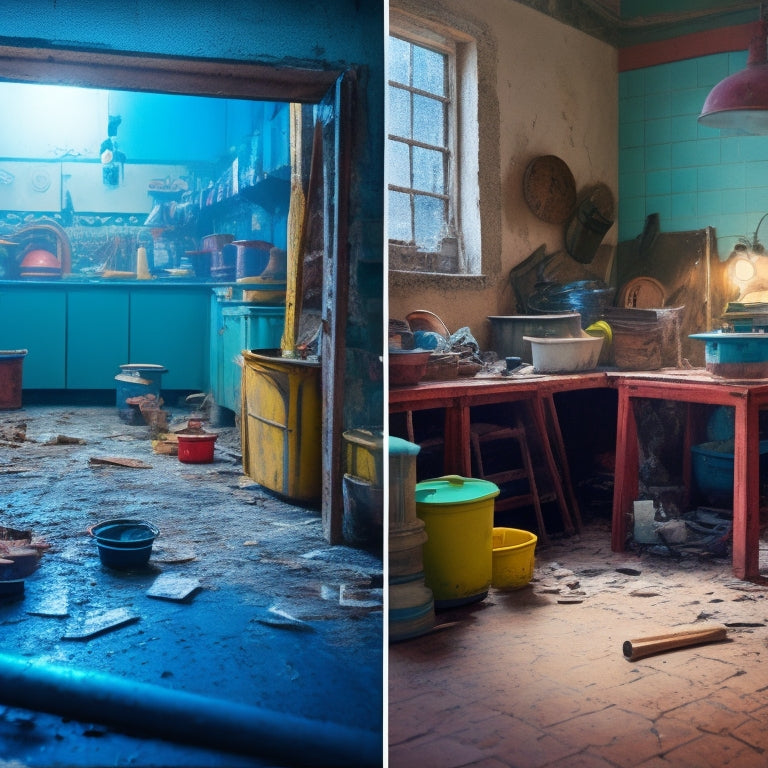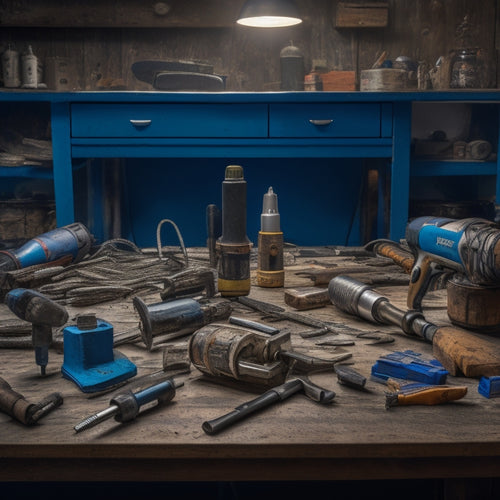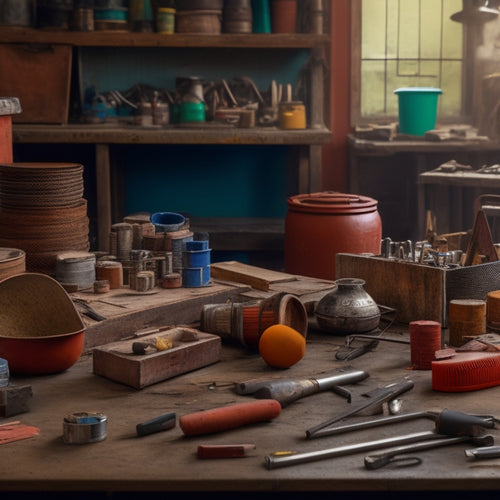
Why Quality Control Matters in Home Renovation
Share
When you invest in a home renovation, quality control matters because it guarantees your project meets design specifications, maintains high construction standards, and reduces long-term repair costs. Regular inspections help identify defects early, preventing costly rework and guaranteeing overall project success. By prioritizing quality control, you'll experience increased satisfaction, leading to positive referrals and business growth. Furthermore, consistent quality enhances your project's reputation. To secure a successful renovation, it's crucial to understand the importance of quality control – and the steps you can take to guarantee it.
Key Takeaways
• Quality control ensures adherence to design specifications, maintaining high construction standards and reducing long-term repair costs.
• Regular site inspections and material checks help identify defects early, reducing the risk of costly rework and accidents.
• Effective communication strategies, including open channels and clear expectations, prevent misunderstandings and delays among stakeholders.
• Consistent quality control enhances overall project success, client satisfaction, and business reputation, leading to positive referrals and growth.
• Proactive quality control measures, such as site preparation and concrete curing, contribute to the durability and integrity of the renovated property.
Essential Steps for Quality Control
During the home renovation process, you must implement a series of vital steps to guarantee quality control, starting with a thorough project planning and scope definition to establish clear expectations and prevent misunderstandings. This important step sets the tone for the entire project, making sure that all stakeholders are on the same page.
Next, you should develop a detailed quality assurance plan, outlining the renovation standards and protocols to be followed throughout the project. This plan should include regular site inspections, material testing, and workmanship assessments to verify compliance with industry standards.
Additionally, it's important to establish a clear communication channel with your contractor or project manager to address any concerns or issues that may arise.
By following these vital steps, you can make certain that your renovation project meets the highest quality standards, minimizing the risk of defects, delays, and cost overruns.
Preventing Costly Concrete Mistakes
When it comes to concrete work, even slight mistakes can lead to costly repairs, structural damage, or even collapse, making it essential to take proactive measures to prevent these errors from occurring in the first place.
As you begin your home renovation project, you must guarantee that your concrete mix is accurately proportioned and mixed to achieve the desired strength and durability. Inadequate concrete reinforcement, such as insufficient rebar or inadequate spacing, can lead to structural weaknesses and compromise the integrity of your foundation or walls.
To prevent these costly mistakes, you should work with a qualified contractor who's experienced with concrete work. They'll guarantee that the concrete mix is properly proportioned and mixed, and that the reinforcement is accurately placed and secured.
Additionally, regular inspections and testing can help identify any potential issues before they become major problems. By taking these proactive measures, you can rest assured that your concrete work is done correctly, and you'll avoid the financial and safety risks associated with costly repairs or structural failures.
The Importance of Site Preparation
You'll need to prepare your site carefully before commencing concrete work to guarantee a stable and even foundation, as any irregularities or obstructions can compromise the structural integrity of your renovation project.
A well-prepared site guarantees that your concrete foundation is laid on a solid base, free from defects and weaknesses.
To achieve this, you'll need to take into account the following key aspects:
-
Clear the site: Remove any debris, vegetation, and obstructions to create a clean slate for your renovation project.
-
Conduct a site survey: Identify any potential issues with the site layout, including drainage, slope, and soil conditions.
-
Select the right materials: Choose materials that are suitable for your project, taking into account factors such as climate, soil type, and structural requirements.
Identifying Defects in Concrete
Concrete defects can manifest in various forms, from minor cosmetic issues to major structural problems. It's vital to identify them early on to prevent costly rework and secure the longevity of your renovation project.
As you inspect the concrete, look for signs of cracking, scaling, or spalling, which can indicate underlying structural issues. You should also check for surface defects like honeycombing, bug holes, or uneven finishes, which can compromise concrete durability.
To conduct a thorough defect assessment, you'll need to examine the concrete's surface and subsurface. Use visual inspection, non-destructive testing methods, and laboratory testing to identify defects and determine their severity.
Pay attention to areas with high-stress concentrations, such as joints, corners, and edges, where defects are more likely to occur. By identifying defects early, you can take corrective action to prevent further damage and guarantee the concrete meets the required standards for strength, durability, and safety.
Ensuring Proper Concrete Curing
Proper curing is critical to achieving the desired strength, durability, and appearance of concrete, as it allows the cement paste to hydrate and harden correctly. Any mistakes during this process can lead to significant defects and compromised structural integrity. As you oversee the renovation, you must verify that your contractor is using the right curing techniques to prevent defects.
Here are three critical aspects to take into account:
-
Moisture retention: The concrete surface must be kept consistently moist to facilitate hydration. This can be achieved using techniques like misting, fogging, or applying a concrete curing compound.
-
Temperature control: The ideal temperature for curing concrete ranges from 50°F to 70°F. Extreme temperatures can affect the hydration process, leading to defects.
-
Protection from external factors: You must protect the concrete from wind, rain, and direct sunlight, which can cause uneven curing and defects.
Additionally, contemplate using concrete additives that enhance the curing process, such as retarding agents that slow down the hydration process, allowing for more even curing.
Role of Inspections in Quality
As you verify that your contractor is using the right curing techniques, it's equally important to conduct regular inspections to catch any potential defects or issues before they become major problems. This is where a well-planned inspection schedule comes into play.
You should establish an inspection frequency that aligns with the project's timeline and milestones. For instance, you may want to conduct daily inspections during critical phases, such as foundation work or electrical installations.
In addition to frequency, it's crucial to take into account the types of inspections you'll need. Visual inspections can help identify surface-level defects, while more in-depth inspections may require specialized equipment, like thermal imaging or acoustic testing.
Don't forget to inspect materials and equipment before they're installed to guarantee they meet the project's specifications. By catching defects early, you can prevent costly rework, reduce the risk of accidents, and assure your dream home is built to last.
Maintaining a Clean Worksite
By designating a specific area for storing materials and tools, you can prevent clutter from accumulating on the worksite and confirm that your contractor's team can work efficiently and safely. This is an essential aspect of maintaining a clean worksite, which is vital for guaranteeing worksite organization and adhering to safety protocols.
Here are some key elements to focus on:
-
Designated storage areas: Assign specific zones for storing materials, tools, and equipment to keep them organized and out of the way.
-
Clear walkways: Verify that walkways are clear of debris and obstructions to prevent tripping hazards and allow for easy movement around the site.
-
Regular cleanup: Schedule regular cleanup sessions to remove waste and debris, reducing the risk of accidents and maintaining a safe working environment.
Effective Communication Strategies
To guarantee that your home renovation project stays on track, establish open and transparent communication channels with your contractor. This involves setting clear expectations, defining key milestones, and scheduling regular progress updates.
This will make certain you're always informed about the project's status and can address any concerns promptly. Regular project updates should include detailed reports on completed tasks, upcoming activities, and any changes to the project scope or timeline. You should also receive regular requests for client feedback, allowing you to provide input on the project's progress and identify areas for improvement.
It's essential to establish a clear communication protocol with your contractor, specifying how often you'll receive updates, the format of these updates (e.g., email, phone calls, or in-person meetings), and the best communication channels for urgent matters.
Avoiding Delays and Cost Overruns
You can minimize the risk of delays and cost overruns by closely monitoring your project's progress and identifying potential roadblocks early on. This proactive approach allows you to make adjustments before issues escalate, guaranteeing your renovation stays on track and within budget.
Here are three key strategies to help you avoid delays and cost overruns:
-
Regular project scheduling reviews: Schedule regular meetings with your contractor to review the project timeline, discuss progress, and identify potential delays.
-
Budget management and contingency planning: Set aside a contingency fund to cover unexpected expenses, and regularly review your budget to confirm you're staying on track.
-
Proactive issue resolution: Address potential issues as soon as they arise, rather than waiting until they become major problems. This includes identifying and resolving design flaws, material shortages, or labor issues promptly.
Frequently Asked Questions
How Do I Handle Disputes With My Contractor Over Quality Issues?
When handling disputes with your contractor over quality issues, you'll want to prioritize effective communication.
Clearly document the problems, specifying the exact issues and why they don't meet your expectations.
Schedule a meeting with your contractor to discuss the concerns, focusing on resolution rather than blame.
Be open to compromise, and consider bringing in a neutral third-party mediator if necessary.
Remember to stay calm, professional, and solution-oriented to resolve the dispute efficiently and safely.
Can I Perform Quality Control Checks Myself, or Do I Need a Professional?
You're wondering if you can perform quality control checks yourself or if you need a professional.
While it's possible to conduct DIY inspections, it's crucial to reflect on the complexity of the project and your level of expertise.
For quality assurance, it's advised to hire a professional inspector, especially for critical systems like electrical and plumbing.
They'll identify potential issues you might miss, ensuring your safety and the project's integrity.
What Are the Consequences of Not Having a Quality Control Plan in Place?
You're building a house of cards without a quality control plan, and it's only a matter of time before it all comes crashing down.
Without a quality control plan, you risk compromising renovation standards, and your contractor's expertise is wasted on subpar work.
You'll be left with a finished project that's riddled with defects, safety hazards, and costly rework.
Don't let your dream home turn into a nightmare – prioritize quality control to guarantee a safe and successful renovation.
How Often Should I Inspect the Renovation Site for Quality Control Purposes?
When it comes to inspecting the renovation site for quality control, you'll want to establish a regular site inspection frequency. Aim to inspect the site daily or weekly, depending on the project's complexity and pace.
Develop a renovation checklist with strategies to identify potential issues early on. This will help you catch defects or non-compliance before they escalate, ensuring a safer and more efficient renovation process.
Can I Sue My Contractor for Failing to Meet Quality Standards?
If you're dealing with a contractor who's failed to meet quality standards, you may have legal remedies available.
You'll need to prove contractor negligence, which can be a complex process. Document everything, including communication with the contractor, site inspections, and any defects or issues.
Consult with a lawyer to determine the best course of action and explore your options for seeking compensation.
Conclusion
By prioritizing precision, prudence, and planning, you'll pave the way for a successful home renovation.
Effective quality control measures will safeguard your sanity, space, and budget.
Remember, meticulous monitoring and swift corrections can mean the difference between a dream dwelling and a costly catastrophe.
Stay vigilant, and your vision will take shape with precision and perfection.
Related Posts
-

Streamlining Your Exterior Renovation Timeline
To streamline your exterior renovation timeline, start by identifying your project goals and objectives, and prioriti...
-

What to Look for in Pneumatic Renovation Tools
When selecting pneumatic renovation tools, you'll want to take into account several key factors to guarantee optimal ...
-

Budget-Friendly Materials for Your Home Renovation Needs
As you initiate your home renovation, you're enthusiastic to find budget-friendly materials that fit your vision with...


